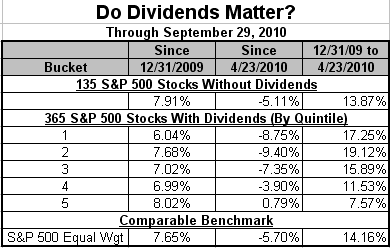- MarketBeat (WSJ Blog) – Here’s Why You Should Care about Dividends: ‘Bladder Theory’
A particularly pesky commenter has been tagging some our recent flurry of dividend-focused posts with this question: “Why do people care about the dividend yield? Doesn’t Modigliani-Miller imply we shouldn’t care except for tax reasons? And for tax reasons, it seems no dividend is better since you can choose when to realize a capital gain, but not a dividend.”…The theory suggests investors should be agnostic as to how stocks generate return. For instance, if a stock yields 10% a year, 3% might be in dividends and 7% might be capital appreciation. But if the company, had not decided to pay that money out in dividends that that cash would still belong to the shareholder. It would just be sitting on the balance sheet of the company instead of in the shareholder’s pocket. That cash balance would be incorporated into the market’s view of the company’s prospects, likely raising the capital appreciation component of its total return over time. That’s the theory at least. But in practice there’s an emerging sense it’s not always a good thing for companies to be rolling in cash. Some argue it might be a good discipline for management to be forced to pay out dividends. - MarketBeat (WSJ Blog) – BofA Quant: Dividends Strongest Performing Theme This Year
Savita Subramanian, quantitative strategist for Bank of America Merrill Lynch says that dividend-oriented strategies have delivered the most consistent returns in 2010, but dividends are still an unloved part of the market:
In 2010, dividend oriented strategies have offered the strongest and most consistent returns despite the “risk-on / risk-off” nature of the market, and dividend yield and dividend growth are strategy leaders in the year to date. However, our work suggests we’re still in the early stages of building interest, given that dividend yield still remains a somewhat underutilized investment theme. Fund manager holdings show that Utilities, Staples and Telecom Services – sectors with the most attractive yield – are the most hated sectors, and have been for quite some time.
Comment
The table below breaks down the performance of the S&P 500 stocks by dividend yield:
- The top of the table shows the performance of the 135 stocks that do not have dividends
- The middle of the table breaks down 365 stocks stocks that do have dividends by quintile (1 =73 lowest dividend yielding stocks, 5 = 73 highest dividend yielding stocks)
- Since these measures are calculated on an equal weighted basis, the bottom of the table shows a proper benchmark, the S&P 500 equal weight index
- April 23, 2010 was the S&P 500′s 2010 high (1217.28)
What we found is rather surprising:
- Year-to-date, owning dividend yielding stocks versus non-dividend yielding stocks has not mattered. The differences shown are not material. This stands at odds with the comments highlighted above.
- Since the high of the year, however, higher dividend yielding stocks (quintiles 4 and 5) have materially outperformed the lower dividend yielding stocks (quintiles 1 to 3) and non-dividend stocks.
- Similarly, from December 31, 2009 to April 23, 2010, lower dividend yielding stocks (quintiles 1 to 3) and non-dividend yielding stocks outperformed the higher dividend yielding stocks (quintiles 4 and 5).
Conclusion
When the market is rallying (through April 23), the more speculative non-dividend and lower dividend yielding stocks outperform the more conservative higher dividend yielding stocks. When the market is moving sideways-to-lower (since April 23), higher dividend yielding stocks outperform.
This is not new and not unique to this environment. Instead this is fairly typical market action. It suggests the opinion that dividend yielding stocks present a unique opportunity is not supported by market returns.



What's been said:
Discussions found on the web: